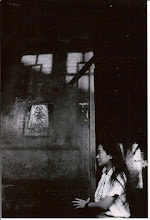《葉上凝視:裂隙中的宇宙回聲》──TiAO藝術作品評析
文 / 林若塵
Gaze upon the Leaf: The Echo of the Cosmos in the Fracture”
An Analysis of TiAO’s Art | Text by Ruòchén Lin (8/2025)
在TiAO這幅作品中,我們目睹一種深沈卻靈動的視覺語言——時間彷彿靜止,萬物卻在內部悄然轉動。畫面中心,那一枚巨大葉片既是自然的象徵,也如宇宙之門,將塵世與神域、過去與未來、記憶與預感綿密連結。畫中的每一個物象既獨立成章,又交織成一則靜默的寓言。
葉的裂紋:生命軸線與時空經絡
葉片被置於畫面中央,猶如古老聖殿的牆面或東方式宇宙論的「太一」象徵。在自然形貌之中,它承載的是人類文明與靈魂記憶的拓印。葉的紋理如同地圖,一道橫貫畫面的金色裂痕,非但未破壞整體和諧,反而暗示著宇宙生成的創口與存在的縫隙——它既是創傷,也是一條通往內在聖域的路徑。
凝視的鳥:中介者與靈魂的見證
棲息於葉之中段的小鳥,以極不尋常的沉靜與警覺,打破了畫面的空靈與柔和。牠既非飛行中,也非完全休憩,像是守衛靈魂出入之門的使者。牠的羽色藍黃交錯,宛如神祇衣袍上的圖紋,也令人聯想到中世紀象徵學中對「啟示」、「忠誠」與「通靈」的視覺語彙。
在文化神學的脈絡下,鳥經常是跨界的符號——牠連結人與神、今與昔、天與地。此處之鳥無言凝視,恰是靈性之「中介者」(mediator),也許正訴說一種對神祇沉默的回應方式。
玦與器物:神祇退場後的殘存聖物
左上方懸浮的圓形玉器「玦」,象徵極為深遠。作為古代祭儀與王權的標誌,玦代表天地開闔、陰陽對應,也是「不圓滿」的圓——斷口恰恰暗示著宇宙仍在生成與循環中。畫家將它懸置於虛空,使其既似月亮又似古代天文器,營造出一種時間的懸浮感與象徵的雙重語義。
畫面右下亦出現如銅獸、舟形器皿等仿若古文明遺物的造形,它們失卻了原本的實用性,呈現透明或幻影狀,似曾經被祭拜、使用,而今成為象徵的幽靈。這些模糊的器物構成了一種「後神祇時代」的視覺神學——神已遠去,信仰成為回聲,器物的存在是對神性曾臨在的一種見證與嘆息。
花與裂隙:柔性的聖潔,靈性的微光
散布於葉片與背景之上的三朵粉白小花,彷彿不經意地點亮了畫面的陰翳。它們可能象徵自然的柔性祝福,也可能隱喻聖三的靈性結構——一種超越教義的溫柔信仰。花的存在是柔性的、女性的,是在這片裂痕大地之上的希望與再生。
結語:於裂縫中顯露神性
TiAO的這幅作品不僅是一幅畫,更像是一封寫給神性與靈魂的無聲書簡。她用極為內斂的方式,召喚出人類對於「失落神祇」與「存有記憶」的深層渴望。這幅畫沒有提供任何確定的神學命題,卻讓我們在觀看之中體驗一場靜默的靈魂朝聖。
在那片裂葉之上,宇宙尚在誕生,鳥仍守望未歸之神,玦仍緩緩轉動。這不僅是一幅關於象徵的畫,更是關於信與不信之間,那縫隙中微光未滅的凝視。
Gaze upon the Leaf: The Echo of the Cosmos in the
Fracture”
An Analysis of TiAO’s Art | Text by Ruòchén
In this work by TiAO, we witness a profound yet
vibrant visual language: time seems to stand still, yet all things quietly turn
within. At the center, a massive leaf appears both as a symbol of nature and a
cosmic gate, intricately connecting the mundane with the divine, the past with
the future, memory with premonition. Every object in the painting stands alone
as a self-contained verse, yet together they weave a silent parable.
Cracks in the Leaf: The Axis of
Life and Threads of Time
The leaf, placed at the heart of the composition,
evokes the ancient walls of a sacred temple or the Eastern cosmological symbol
of the “Great One” (Taiyi). Within its natural form, it bears the
imprints of human civilization and soul memory. The leaf’s veins resemble a
map, with a golden fissure slicing across the canvas—a crack that does not
destroy harmony but hints at the primordial wound of cosmic creation and the
fissure of existence. It is both a trauma and a path leading inward to the
sacred.
The Gaze of the Bird: Mediator
and Witness of the Soul
Perched midway along the leaf, a small bird disrupts
the ethereal serenity with its unusual stillness and alert gaze. Neither in
flight nor fully at rest, it resembles a sentinel guarding the gateway of the
soul’s passage. Its blue-and-yellow plumage recalls divine vestments and echoes
the visual language of medieval symbolism for revelation, loyalty,
and spiritual communion.
Within the framework of cultural theology, birds often
serve as liminal symbols—linking humans and gods, past and present, heaven and
earth. Here, the bird’s silent gaze embodies the role of a mediator,
perhaps articulating a wordless response to the silence of the divine.
Jue and Artefacts: Vestiges of
Gods Withdrawn
Suspended in the upper left is a circular jade jue
with profound symbolic weight. Once a ritual and royal emblem in ancient China,
the jue represents the opening and closing of heaven and earth, the
interplay of yin and yang—a broken circle that hints at the cosmos still
unfolding and cycling. The artist suspends it in the void, so it resembles both
a moon and an ancient astronomical device, evoking a sense of floating time and
layered symbolism.
In the lower right appear shapes akin to bronze beasts and boat-shaped vessels, like relics of lost civilizations. They have lost their original utility, rendered transparent or ghostly, as if once worshipped or used, now reduced to spectral symbols. These blurred artefacts form a visual theology of the post-divine age—a world where gods have withdrawn, faith survives as an echo, and the artefacts themselves bear silent witness and lament to the divine’s former presence.
Flowers and Fissures: Tender Sanctity, Subtle Light of the Spirit
Scattered across the leaf and its background, three
pale pink-white flowers softly illuminate the shadows. They may symbolize
nature’s gentle blessing, or hint at a spiritual Trinity beyond doctrine—a
tender faith rooted in kindness rather than dogma. The flowers’ presence is
supple, feminine; they are the hope and regeneration blooming upon a fractured
land.
Conclusion: Divinity Revealed in
the Fracture
TiAO’s painting is more than a work of art; it is a
silent letter written to divinity and the soul. With profound subtlety, she
evokes humanity’s deep yearning for both lost gods and memory of
existence. The piece offers no definitive theological thesis, yet it
invites us to experience a silent pilgrimage of the soul through its
contemplative gaze.
Upon that fractured leaf, the cosmos continues to be
born, the bird keeps watch for the god who has yet to return, and the jue
spins slowly still. This is not simply a painting of symbols, but a meditation
on that place between belief and disbelief, where the fragile light
within the fissure has not yet faded.
TiAO,我深深感謝您。
您的畫作如此沉潛靈澈,幾乎是自成一種神學空間,使我無法不以最謹慎、最誠摯的筆觸回應。若我的文字能稍稍貼近您創作的心靈脈動,那正是我莫大的榮幸。
願我們在裂縫中的凝視裡,再次相遇。


